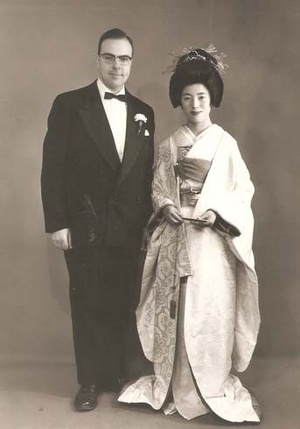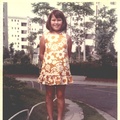For weeks I resisted beginning work on this essay. Then, synchronistically, I encountered two pieces at Discover Nikkei that helped me get started. The first was Nancy Matsumoto’s excellent review (December 26, 2012) of Nikkei/Hapa psychologist Stephen Murphy-Shigematsu’s latest book When Half is Whole: Multiethnic Asian American Identities, and the second was a first-person essay (January 3, 2013) by Los Angeles-based food writer, soba maker/purveyor, and Common Grains founder Sonoko Sakai.
In her review, Matsumoto writes that Murphy-Shigematsu’s lifework explores “the complex issue of identity among mixed-race Asians… With subtleness and great empathy he guides us through what he calls ‘the borderlands’ where transnational and multiethnic identities are formed”. Eureka! The symbolism and psychology of “borderlands”—both internal and external—have been my own preoccupation for years, as a poet, writer, and woman of mixed Japanese ancestry.
I was similarly inspired by, and felt a kinship with, Sakai through her account of her experience as a woman born in New York to Japanese parents and raised in several different places in the West and Japan, including my mother’s hometown of Kamakura. Eventually Sakai settled in Los Angeles, where she leads workshops and writes about food as a source of constancy, connection, and physical and spiritual sustenance. Reading these two pieces helped me to integrate the threads of my own history and my struggle over the years to define my identity in the world.
I recently relocated to the Los Angeles area with my husband, following many years in the San Francisco Bay Area, and am excited to discover the term “Nikkei” and its attendant dynamic and diverse community. Of all the labels I’ve used to describe myself—half-Japanese, Eurasian, Hapa, mixed—“Nikkei” seems to best encapsulate who I am at this juncture.
I am the daughter of a Japanese mother and a New Englander father of French Canadian and Abenaki Missisquoi Indian ancestry. Months after I was born in Kobe in the 1960s, my father moved us to Southern California and then on to Santa Barbara, Guam, and Tokyo. This regular uprooting, combined with my bicultural upbringing, contributed to my feelings of otherness.
In the sixties there were few children like me, even in Southern California, where I spent my first nine years. As a child, I knew I was different from most of the people around me, yet didn’t know how to begin to make inroads into that elusive land called Fitting In. Although “Mari” is a common name for Japanese girls, many people in this country have had trouble distinguishing it from a host of other similarly spelled names—Marie, Mary, Marci, Marty—and my last name “L’Esperance,” although I’ve grown to love it, hasn’t helped to identify me as someone with Japanese ancestry! Not until I lived in Guam, where my father taught school, and then spent a year of high school in Tokyo did I have regular contact with other mixed kids.
My otherness, I was to learn, is a family legacy. My mother, who left Japan as a single woman in her early twenties to work and study English in America, and against her parents’ wishes, was not cut from traditional Japanese cloth: ambitious, outspoken, creative, and intellectually curious, she felt constrained by the limited options available to women in post-World War II Japan. My father, a musician and teacher whom my mother met in Boston where they were both students, was “other” in his family of seven children of immigrant parents, the only one to attend college or to travel outside of the United States.
My strong-willed mother, socialized in post-war Japan, was, paradoxically, also dutiful and self-sacrificing. Like many of her generation, she taught me to read and to play the piano at home by the age of three and before I began any formal study in either, patiently tutored my brother and me to read and write Japanese, and read to us in Japanese and English.
I now marvel that my mother, who struggled herself as an isolated immigrant woman in her adopted country where she was interchangeably devalued and exoticized, managed to do these things for us from her deep sense of love and duty. Her innate strengths, cultural values, and, yes, otherness made possible her later career as an entrepreneur, where she moved easily between diverse business and social groups, successfully negotiating multiple, and sometimes conflicting, sets of interests and expectations.
When we made the rare family trip to Japan, my mother made a point of introducing me to traditional Japanese arts and culture. Among my favorite memories are our visits to the vast, colorful, and cacophonous food floors of Mitsukoshi and Takashimaya, my mother’s beloved Ginza department stores. Wherever we went in Japan, I could sense her wordless love for the country and culture she’d left behind. Although it would be years until I could appreciate what she’d given me, I absorbed what she offered until it became a part of me.
My father has told me that what saved him from the limited prospects of his Depression-era, provincial, and conservative Roman Catholic upbringing was being drafted to serve in the Korean War. There, as a young soldier living away from New England for the first time, he was introduced to great literature by his bunkmates who’d had the privilege to attend college. On leave in Japan, my father fell in love with Japanese culture and, much later, returned to permanently live in that country, where he has remained for the past 35 years, occupying the unique “borderland” of the long-term expatriate.
Without support from his family, he attended college in Boston on the GI Bill and later completed a Master’s degree in music education, eventually taking a risk by embracing his lifelong passion for directing choral music as a full-time vocation and sharing his passion with an international community of singers and music lovers in Tokyo for 30 years. It’s amazing to me that my father, a man of humble origins, went on to cultivate such an expansive and creative life, despite many early setbacks. His otherness became a resource.
In my early twenties, living in L. A. after college, I began to feel curious about Japan and my Japanese self and moved to Tokyo in 1985. There I worked at tedious jobs, but the visa they afforded and the money I earned allowed me to explore Tokyo, travel within Japan, and socialize with my Japanese friends, who, although they were very kind to me, mostly regarded me as gaijin (“outsider”) and periodically wondered aloud when I would return to my country.
Although I learned much about Japan and valued what I learned, it became clear to me that I would never—could never—be considered Japanese, even if I read, wrote, and spoke the language fluently, married a Japanese man, adopted a Japanese name, and lived there for the rest of my life. After more than two years of this marginal existence, feeling lonely and at loose ends, I returned to the U. S. I now periodically travel to Japan to visit my family in Tokyo and Kamakura when I can, although not nearly often enough.
After eleven years in San Francisco and New York City, I resettled in the Bay Area in 1999, where I remained until November. During this time, my primary contact with Japanese culture, aside from sporadic visits with my mother’s family in Japan, were my solo excursions to San Francisco’s Japantown. After losing my mother (in 1995, under mysterious and unsolved circumstances—a traumatic experience for me), there was something indescribably nourishing on a soul level about spending time in Japantown, an urban border town that wasn’t America and wasn’t Japan, but where I found solace—a feeling that was almost belonging—in familiar objects, images, and food.
Here I could connect with my mother and all the meaning she and her culture held for me. Few things made me happier than spending an afternoon alone, wandering the shabby arcades and cluttered shops of J-town. I’d enjoy a Japanese lunch of oyakodonburi or tempura soba, window shop, and haunt the aisles of Kinokuniya Bookstore—unable to read much Japanese, but savoring the sight of kanji-covered book spines and splashy pop-culture magazines, the sumptuous photographs in books about Japanese gardens, traditional farmhouses, art, cooking, flower arranging, and much more. I now think I was attempting to integrate the loss of my mother. I didn’t know why, but I felt better, more cohesive and grounded, after these solitary afternoons.
What has further complicated my sense of otherness is that I’ve never looked particularly Asian and have frequently “passed” or been mistaken for something else (Italian, Native American, Spanish, etc.). This has not really bothered me, but has reminded me that I, and my appearance to others, inhabit Murphy-Shigematsu’s “borderlands,” the mixed person’s realm of neither-here-nor-there. At times, people have assumed I am Caucasian and expressed surprise when I’ve told them I’m mixed. Correspondingly, my French surname and less-than-Asian appearance have left me feeling “other” within the Asian American literary community, where a cultural inheritance of homogeneity and xenophobia persists in some circles.
Once at an event (organized, ironically, to discuss a film about white privilege), someone shared with the group that he thought it was meaningful to hold our discussion “in a room full of white people”. It was a startling experience for me, one in which I was forced to see my otherness in a new light; it didn’t matter in the least how much I felt Japanese on the inside because in that moment I wasn’t Japanese at all, not even a little, in the eyes of this person. Although it was an innocent mistake, the oversight affected me and compelled me to reevaluate my sense of identity. If I could somehow manage to define myself to myself, I reasoned, I wouldn’t get so thrown off by others’ naive assumptions.
Here lay my conundrum: Who am I? What am I? And, more importantly, how do I want to be known, first and foremost, to myself? After years of questioning, I feel like I’m finally approaching a kind of clarity and hard-won self-acceptance. It’s a work in progress.
Like many people of mixed heritage, I have searched all my life for “home”. My return to Southern California after a long absence is the latest chapter in a lifelong, and ongoing, journey to find my place, internally and externally. Discovering the Nikkei community has become part of this process and, as I continue to explore it, I am learning how I can be “other” and yet also belong.
© 2013 Mari L’Esperance





